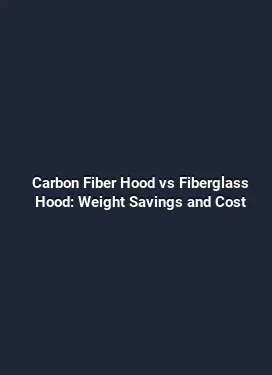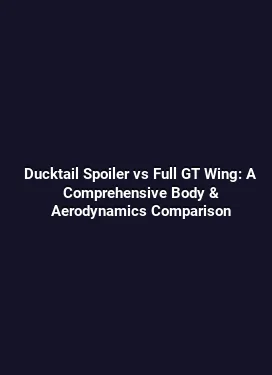Smooth Front End Conversion: Removing Bumper for Better Airflow
In the pursuit of improved vehicle performance, aerodynamic efficiency has emerged as a practical lever a few teams and enthusiasts use to shave tenths of a second off lap times or miles per gallon off fuel consumption. A front-end conversion that involves removing or redesigning the bumper is one approach that directly targets the airflow entering the radiator, intercooler, and the underbody. This article delves into the physics behind such a modification, the tools and methods for implementation, and the trade-offs that come with altering a vehicle’s frontal geometry. Readers will gain actionable guidance on planning, measurement, and validation to ensure that airflow improvements translate into real-world gains without compromising safety or reliability.
Understanding Front End Aerodynamics and the Role of the Bumper

Front-end aerodynamics governs how air behaves as it interacts with the vehicle’s face. The bumper, grille area, and surrounding panels form the first boundary that air encounters. A well-designed front end manages stagnation pressure, vortex formation, and boundary layer development to minimize drag and guide air toward cooling systems and brakes. However, a bumper that is overly aggressive in obstructing the flow can create undesirable effects such as flow separation, increased drag, or uneven cooling distribution. The goal of a bumper removal or redesign is not to eliminate protection but to optimize the path of least resistance for air while preserving structural integrity and pedestrian safety provisions where applicable.
Airflow operates on several scales. On a macro level, the vehicle’s overall geometry determines parasitic drag — the portion of drag not contributing to propulsion. On a micro level, boundary layer behavior along the bumper, grille, and undertray influences local pressure differentials, which in turn affect lift, downforce, and cooling efficiency. When a bumper is removed or replaced with a streamlined cover, the flow can become smoother over the frontal plane and better directed into ducts, which reduces energy losses and can improve high-speed stability. The trade-off often concerns protection, compliance with safety standards, and the risk of debris intrusion; a careful, measured approach helps balance these concerns with performance gains.
Key Aerodynamic Concepts in Front End Modifications

Before undertaking any physical modification, it is essential to understand the core aerodynamic concepts that drive performance outcomes. Boundary layer management, flow separation, and pressure recovery are central to how a front-end change translates into real-world results. A streamlined front end aims to maintain laminar or transitional flow over a larger surface area, delaying separation and reducing wake length behind the vehicle. This directly correlates with reduced drag coefficient (Cd) and improved lift distribution across the chassis, which can translate into faster high-speed performance and more stable cornering dynamics.
It is also important to appreciate how the bumper interacts with cooling performance. While a minimal bumper can reduce frontal drag, it can also alter the available aperture for radiator and intercooler intakes. Therefore, any modification should be evaluated in conjunction with cooling performance, even in cooler climates where engine cooling demands are lower. The balance between drag reduction and cooling sufficiency is a recurrent theme in front-end optimization.
Planning and Design Considerations for a Front End Conversion
A successful front-end conversion begins with a structured plan that aligns performance targets with safety and regulatory constraints. The most effective projects typically follow a phased approach: establish the baseline, model the new geometry, prototype, test, and validate. Each phase should be driven by quantitative metrics rather than intuition alone.
Baseline data collection includes measuring existing drag under controlled conditions, current cooling performance, and access to airflow paths around the bumper, grille, and underbody. Without a robust baseline, it becomes challenging to attribute gains to the modification rather than to ambient conditions. Modern testing often leverages computational fluid dynamics (CFD) simulations to visualize airflow, pressure fields, and potential hotspots. While CFD is a powerful tool, it should be paired with physical wind tunnel testing or road testing to confirm real-world behavior.
When choosing to remove or modify the bumper, consider several design goals: reducing frontal obstruction, improving duct intake efficiency, increasing under-vehicle flow, and maintaining crashworthiness. If the vehicle is used on public roads, local regulations may constrain certain modifications. Pedestrian safety assessments, bumper energy absorption, and airbag deployment considerations should be accounted for within the design process. A modular approach that allows reintroduction of protective features, if needed, can provide flexibility during testing and validation.
Materials, Tools, and Safety Protocols
Material choice for a front-end conversion often centers on lightweight composites or high-strength plastics that can withstand weathering, impact, and UV exposure. If a bumper is removed entirely, temporary protective covers or fairings should be designed to prevent debris ingress and to meet local safety standards. Tools for such work typically include automotive panel removal kits, heat guns, plastic welding equipment, and fastener hardware compatible with body panels. Safety protocols emphasize proper eye protection, hand protection, and secure support for any panels being modified or removed to prevent accidental damage to the vehicle or injury to the technician.
Documentation of the process is crucial. Take photographs at each stage, log the dimensions of any new ducting or opening, and record the testing conditions. This records a repeatable workflow that can be revisited if the vehicle undergoes future maintenance or if the modification must be reversed for warranty or resale reasons.
Implementation Pathways: From Concept to Reality
Implementation strategies can vary from subtle adjustments to more comprehensive front-end redesigns. The three most common pathways are: (1) bumper removal with protective fairing and ducting enhancements; (2) bumper trimming combined with high-surface areal features that guide air more efficiently; and (3) fully redesigned, purpose-built front-end panels that optimize flow while maintaining clearance for critical components. Each approach requires a different level of risk tolerance, cost, and validation effort.
Case studies from the field illustrate practical outcomes. In one scenario, a mid-size sedan with a stock bumper was upgraded with a mid-hood intake enhance ment and a low-profile, smooth undertray. CFD indicated improved flow attachment along the centerline, and road testing confirmed slightly lower drag and a modest gain in stability at highway speeds. In another instance, a sports coupe employed a modular front end that could be removed for track use, enabling optimized airflow at the front when needed, while preserving street-legal safety features. While these examples demonstrate potential gains, they also highlight the importance of verifying cooling performance and structural integrity under dynamic conditions.
Balancing Cooling, Drag, and Structural Integrity
One of the most challenging aspects of front-end conversion is maintaining adequate cooling while reducing drag. The radiator and intercooler rely on consistent air inflow through the grille and intake ducts. Any modification that reduces the available cooling air can lead to elevated engine temperatures under load, which may trigger thermal protection mechanisms or reduced performance. A practical approach is to design a dynamic ducting system that adapts the airflow to cooling demands while minimizing drag during steady-state cruising. This may involve adjustable vents, sealed but reversible baffles, or heat-driven flaps that open under high-temperature conditions while remaining closed during low-load driving.
Structural integrity remains paramount. Even if the bumper is removed for performance reasons, the vehicle must retain crash energy absorption characteristics. This often means integrating alternative reinforcement strategies, such as a strong, low-profile bumper beam or mount points that preserve the integrity of crumple zones. Certification and safety testing may be required for commercially sold variants, but for hobbyist projects, following OEM guidelines and using certified aftermarket parts is a prudent path to maintain compliance and preserve resale value.
Testing and Validation: From Lab to Road
Validation is the bridge between theoretical gains and real-world performance. A robust testing protocol includes wind tunnel data, CFD metrics, and on-road measurements. Wind tunnel testing enables controlled measurements of drag, downforce, and flow uniformity around the front end. CFD complements this by offering insights into flow separation points, pressure coefficients, and potential recirculation zones that might not be easily observed in a wind tunnel alone. Road testing, with instrumentation such as high-precision data loggers and infrared thermography, provides the ultimate proof of how the modification behaves under varying speeds and loads.
Key metrics to monitor include the drag coefficient (Cd), the overall coefficient of pressure, cooling system delta temperatures, brake temperatures under sustained braking, and fuel efficiency for road-driven tests. For performance-oriented builds, throttle response, steering feel, and high-speed stability are additional indicators of successful aerodynamic tuning. The integration of telematics and data-analysis software allows the practitioner to identify correlations between frontal airflow changes and measurable improvements, turning subjective observations into data-driven conclusions.
Practical Validation Techniques
Practical validation often combines simple, repeatable tests with more advanced instrumentation. A basic drag proxy can be obtained by measuring steady-state fuel economy at a controlled highway speed range before and after the modification. More precise methods include establishing a consistent testing route with GPS-based velocity data and an external pressure sensor array to gauge pressure recovery behind the bumper opening. For cooling validation, monitor coolant temperatures and radiator fan activity under sustained high-load conditions. If possible, replicate a track or endurance scenario to observe how the system behaves under thermal stress.
Noise, Vibration, and Harshness (NVH) considerations should also be part of the validation plan. Modifications can alter the tonal characteristics of the airflow around the front end, potentially creating new wind noise paths. A practical approach is to perform acoustic measurements at multiple speeds and to incorporate aero-acoustic considerations into the final design, such as smoothing sharp transitions and reducing abrupt cross-flows that generate tone-rich noise bands. A well-executed design minimizes both drag and unwanted noise, contributing to an overall more refined driving experience.
Maintenance, Durability, and Long-Term Impacts
Any modification to the front-end geometry can affect durability and maintenance routines. The absence or alteration of a bumper increases exposure to road debris, insects, and weathering. Protective coatings, sealants, and periodic inspections of fasteners and mounting points help ensure long-term reliability. It is critical to inspect the front-end assembly after heavy use, especially after winter driving or rough-road events where debris and ice can stress the upfront panels. A proactive maintenance schedule reduces the likelihood of unexpected repairs and helps preserve the aerodynamic advantages gained from the conversion.
Durability considerations also extend to the longevity of cooling components. With altered airflow patterns, the radiator and condenser may experience different dust accumulation rates and airflow velocities. Regular cleaning of grilles, ducts, and heat exchangers becomes an essential part of upkeep to maintain cooling efficiency and prevent thermal-related performance degradation. In some cases, aftermarket air filtration or screen options can mitigate debris ingestion while preserving airflow, but these components should be selected to minimize pressure drop and avoid obstruction of important intake paths.
Trend Integration: LSI Terms and Future-Proofing Your Front End Strategy
In the broader landscape of Body & Aerodynamics, several trends influence how front-end conversions evolve. The use of dynamic aerodynamic elements, such as active flaps and adaptive vents, is becoming more common in performance-minded street vehicles. The integration of lightweight composites and modular panels reduces the weight penalty that often accompanies functional aero upgrades. Across the industry, a growing emphasis on computational validation, real-world telemetry, and certified safety standards ensures that aerodynamic gains are measured, repeatable, and scalable between platforms.
To keep content relevant and actionable, practitioners can focus on a few practical areas: (1) transparent documentation of all design decisions; (2) iterative testing cycles with clearly defined success criteria; (3) ensuring compatibility with existing propulsion, cooling, and safety systems; and (4) engaging with communities or professional shops that offer validated components and tested methodologies. This approach not only accelerates development but also reduces the risk of unintended consequences when pursuing faster, more efficient front ends.
Conclusion: A Cautious Path to Aerodynamic Gain
Optimal front-end modifications demand a measured balance between drag reduction, cooling sufficiency, structural integrity, and compliance with safety requirements. A bumper-free or bumper-reimagined front end can yield tangible benefits in drag reduction, high-speed stability, and sometimes fuel efficiency, but these gains must be validated through a rigorous testing program. The path from concept to road-ready implementation hinges on methodical design, robust data collection, and a willingness to iterate based on empirical findings.
Ultimately, the pursuit of smoother front-end airflow is a holistic engineering challenge. It requires a clear understanding of fluid dynamics, a respect for safety and reliability, and a practice of validating changes with real-world measurements. When approached with discipline, front-end conversions can unlock meaningful performance improvements while preserving everyday drivability and long-term durability.






